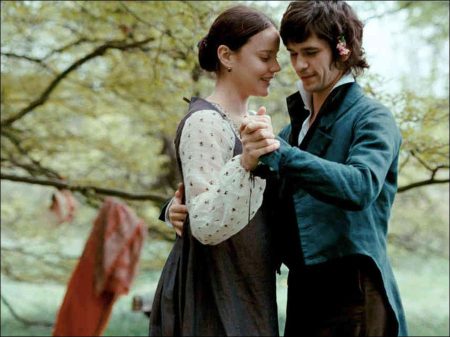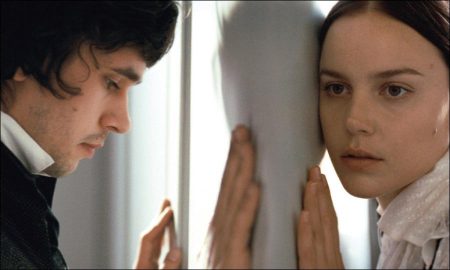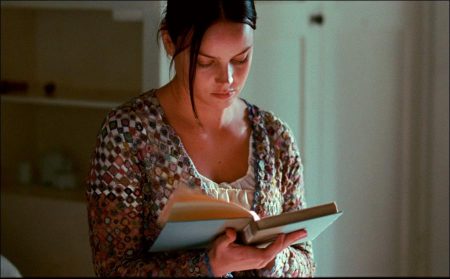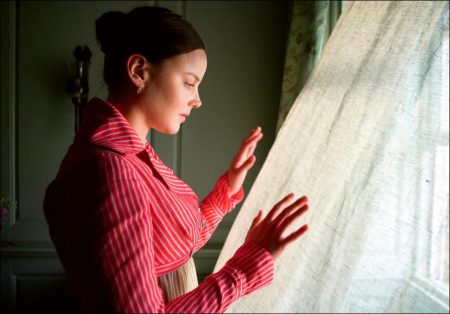Tagline: First love burns brightest.
London, 1818 – a secret love affair begins between 23-year-old English poet John Keats and the girl next door, Fanny Brawne, an outspoken student of fashion. This unlikely pair started at odds; he thinking her a stylish minx, she unimpressed by literature in general. But when Keats’s younger brother falls ill John and Fanny are drawn together. Keats, touched by Fanny’s efforts to help care for his brother, agrees to teach her poetry.
Bright Star movie storyline. By the time Fanny’s alarmed mother (Kerry Fox) and Keats’s best friend Charles Armitage Brown (Paul Schneider) realize their attachment, the relationship had an unstoppable momentum. Intensely and helplessly absorbed in each other, the young lovers were swept into powerful new sensations: “I have the feeling as if I were dissolving,” Keats wrote to her. Together they rode a wave of romantic obsession that deepened as their troubles mounted. Only Keats’s own fatal illness proved insurmountable.
Director’s Notes
The film is in itself a kind of ballad, like Keats’s ‘Eve of St Agnes’ – it is a story about the love affair of Fanny Brawne and John Keats. The story progresses in verses charting their increasing involvement and attachment as well as their deepening difficulties.
The storytelling’s restraint mimics Fanny’s own life restraint, the passive waiting fate of any young woman of her time: the life amongst the family, her obsession with sewing, the restrictions on her activities and her chaperoned outings. Against all these restraints, her determined passion for John Keats expressed through the notes she left under his pillow or by presenting herself at his window when he was sick, seem all the more remarkable.
The most important quality of this story was to get across the intimacy of the characters to the viewer. Rehearsal was very important for this as it helped the actors to establish a subtle Being. Both Ben Whishaw and Abbie Cornish have a particular delicious charisma which, through the rehearsal period, they gave their characters claim to. The more real they are, the more the mystery of their unique personalities is allowed to fascinate us, capturing our imagination and our hearts.
I see the world of Keats and Fanny as light filled, literally leaking light, and even though the film ends with Keats’s death, the lamp lit by his poetic genius and unique spirit cannot be extinguished. It is Bright Star’s ambition to sensitize the audience, to light the lamp. – Jane Campion, writer and director
Production Story
Romantic poet, John Keats’s love for Fanny Brawne inspired some of the most beautiful love letters ever written. The eldest daughter of the Brawne family, Fanny was initially considered by Keats as a ‘minx.’ But whilst living next door to her in Hampstead, north London, between 1819 and 1820, he enjoyed a stupendous burst of creativity, producing three of his most beautiful works of poetry: ‘Ode on a Grecian Urn,’ ‘Ode on Melancholy’ and ‘Ode to a Nightingale.’
The pair became unofficially engaged in October 1819, but their wedding day would never arrive. Stricken by tuberculosis, Keats was advised to convalesce in a warmer climate, and left Britain for Italy in 1820. He never saw Fanny again and died in Rome in February 1821 at the young age of 25, as the celebrated poet he would later become. His final poem was called simply: ‘To Fanny’.
Brawne mourned Keats as if they had been married, wearing a widow’s black dress for three years and spending hours in her room re-reading his letters or wandering alone on Hampstead Heath. In 1833 she married and later had two children, but she never took off the ring Keats had given her. She also kept over three dozen of Keats’s love letters to her. Many were mere notes, others lengthy chronicles of his devotion. These letters have become celebrated as among the most beautiful ever written.
The film’s title, Bright Star, comes from a love poem for Brawne which Keats wrote in the flyleaf of his copy of the works of Shakespeare. The project had been a dream of director Jane Campion’s for several years. “I was reading a biography of Keats,” she says. “I got to the part where he met Fanny and I fell in love with their story. I was drawn to the pain and beauty and innocence of their love affair.
I was incredibly moved by Andrew Motion’s book. They were so young; it was a true life Romeo and Juliet story well-documented but one I had not known. I found myself weeping at the end of it. The story is so tragic and tender. The book also connected me to his poetry; I realized he was writing about his life and what he was going through. At that point I couldn’t really imagine what kind of film you could make. I’m not really a fan of the biopic. I felt like I needed a specific angle.”
Campion decided to tell Keats’s story through the lesser-known eyes of Fanny. We meet Keats, discover his poetry and lose him, as she does, over a two year period. The story is informed from a variety of sources including Keats’s letters and poems and Andrew Motion’s moving and fulsome biography of Keats.
Keats’s poetry provided the inspiration for the structure of the story as Campion explains. “Some of Keats’s poems are in the form of odes and some are in ballads and I started to think about the story of Fanny and Keats as a ballad, a sort of story poem.”
The film stays as true to history as possible. I needed to invent the story between the facts. I was very conscious of remaining modest and true to the spirit of these two extraordinary beings. Keats was easy, his personality, his playfulness that I read in his letters felt very familiar. But as Keats destroyed his letters from Fanny I had less to guide me for her character. For example, Fanny sometimes showed remarkable restraint.
On returning home after saying a final farewell to Keats when he left for Rome, she simply wrote in her diary “Mr Keats left Hampstead.” Yet Keats also quoted Fanny in a letter to his friend Brown in the days preceding his departure as repeatedly asking, “Is there another Life? Shall I awake and find this all a dream? There must be. We cannot be created for this sort of suffering.” Then there was the summer of extraordinarily passionate love letters, which to receive must have been overpowering, so it was amidst these contrasts between passionate outpouring, grieving and extraordinary restraint that helped set the world in which they faced their fate.”
Campion’s long-time collaborator Jan Chapman (The Piano, Lantana) produced the film and consulted with Campion on the development of the screenplay after early backers Pathé came on board. “I had really fallen in love with Keats’s poetry in my last year at high school. He was a sensualist about nature; you can feel the experience of it in his poems. There’s also a really palpable sense of young love, of the transience of that and of the desire to capture a moment and never let it go. I responded immediately to Jane’s interest in the love story being told from Fanny’s point of view.”
“The film is a true co-production in that it wasn’t forced in any way. Screen Australia joined Pathé as investors followed by BBC Films, the UK Film Council’s New Cinema Fund, the New South Wales Film and Television Office and Hopscotch International.” Deciding to shoot in the UK, Chapman brought on board English producer, Caroline Hewitt (Mr Bean’s Holiday, The Hitchhiker’s Guide To The Galaxy). Hewitt knew the team socially after producing Jane’s sister Anna Campion’s Loaded.
Hewitt was delighted to be involved. “It was a beautifully written script, poetic but with a modern cadence which makes it hugely accessible. It was almost a shock to read something so good, it was one of the best scripts I’ve ever read. Although it’s a period film, it is very modern, immediate and pertinent and completely universal, about first love and creativity.”
For Hewitt the script was given texture by the relationship between Keats, Fanny and Keats’s friend Brown, with whom he lived and worked. “One of the most interesting things in it for me was the effect that love has on the creative person. Are you distracted or does it enhance it? This was the central core of the whole thing, his relationship with Fanny and his relationship with Brown and the way the territory of Keats is fought over. The idea of having propriety over someone else’s creativity is very interesting. Brown sees Fanny as a flibbertigibbet, but she has a very deep capacity for understanding what Keats is about and who he is. And that takes it beyond a straightforward love story.”
To Hewitt, their differing attitudes to love were also key. “Brown shows a broader crasser and casual idea about what love could be, while Keats has a spiritual, passionate and deep love. They each represent a different state of masculinity.” Campion’s vision does not feel like typical corseted UK fare. “Jane’s script is totally immediate,” explains Hewitt. “You’re not removed emotionally by the historical nature of this. The film is unfussy – minimal but beautiful.”
Bright Star’s two leads, Abbie Cornish and Ben Whishaw, also helped clear out any stuffiness that might be expected with a story starting in 1818. “Period films can feel stuffy and you need actors to feel real,” says Campion. “Abbie can make things feel so immediate. And Ben’s also very real.”
Chapman agrees the casting has also been crucial. “We wanted to have the freedom to cast the actors of our choice and we happened to choose leads from each country. Abbie and Ben are quite exceptional. They completely surpassed our wildest dreams in bringing the two characters to life.”
“I remember first meeting Ben Whishaw outside the audition room. I looked at this young man, this creature, beautiful like a cat, not real almost. When he spoke, he sounded like Keats, not posh, slightly London or northern. In the audition he was completely brave, open emotionally, febrile yet strong and very sensual and intimate with the actress reading for Fanny. Later in rehearsal I found his presence addictive. Ben is not chatty but deeply honest and trusting. When Ben and Abbie finally first met before rehearsals, I remember Abbie saying something like, “G’day mate.” As underplayed as those first words were, it was a special match,” continues Campion.
“We were very lucky with Ben as Keats,” adds Chapman. “He somehow encapsulates the innocence of a young man but with a great deal of wisdom. Keats was very determined to express whatever his art was – which was poetry in this case – it could have been as a musician these days. Although, Keats trained to be a doctor, he was determined to be a poet.”
Ben Whishaw was ‘ecstatic’ to be cast in the central role. “I found the script really moving and I was in tears by the end of it. That’s what I always look for, an emotional response to something. I didn’t know anything about him [Keats], but something in it hit me. When I went for the audition I had a possessive feeling about it, this is mine, I understand this person.”
For Whishaw the role also brought a sense of responsibility. “The more I read about him, the more I realized there was centuries devoted to literature about this man and so many people had their own notion of who he was. You want to be able to honor that in some way and realise this man in a way that is true for them, but you also have to be true to your own vision and Jane’s vision of him, which is probably the most important thing. Jane sees him as somebody with a larger capacity than most of us to be open to the divine: a kind of angel. I think he was very complicated and probably a genius. Anybody that complex has all manner of layers and facets that you can’t hope to express in a two hour film.”
Campion found herself using her daughter as inspiration for the character of Fanny. “Writing Fanny was difficult as I don’t think of myself as witty. My daughter Alice who is 13, however, is very passionate and quick speaking, so whenever I got to a point when I thought ‘what would Fanny do about this?’, I thought what would Alice do about it, and that really helped me out. She was a kind of muse for me. Then along came Abbie. She’s a singular minded person and would definitely have the courage to do what Fanny did; to go against what society thought was suitable and to pick a partner who was almost inevitably going to cause her extraordinary pain. Abbie can make anything sound present and real. I don’t know how she does it. She’s got this knack of turning words on a page into something that’s real in the world. I was never sure how she was going to go with any particular thing, but she certainly had Fanny under her skin. I was not only surprised and moved by the depth of her performance, but also by how funny and light, even silly she can be.”
Chapman worked as executive producer on Cornish’s breakout film Somersault in 2004, and believed the Australian actress could master an English accent. “I was excited by the idea of Abbie being cast as Fanny,” says Chapman. “Abbie has an incredibly direct gaze and focus but she can also express youthful, uncontrolled feelings really well. Fanny goes from being a light-hearted girl, whom Keats describes as a minx, to someone with great gravitas.”
Cornish was attracted to the project by the strength of the script and the characters. “I fell in love with the script as soon as I read it. It bounced off the page into my imagination and just came to life. She’s such a gorgeous character. She’s just starting to discover love and find herself through love. Keats opens her to life and I thought that was really beautiful. It’s such a beautiful love story.”
She adds, “I was also very interested by the journey Fanny goes on in these two years: falling in love, getting engaged and having the person she loves die. When you’ve played a character that’s actually existed there is a huge responsibility to play it as honestly and as truthfully as possible. You research their life and then you try to transport that through your acting, but you also have to trust your instinct and what feels right and I think it’s incredibly important to follow that.”
Kerry Fox, who starred in Campion’s An Angel at my Table joined the cast as Fanny’s mother Mrs Brawne. “This character was very important to me. Having a daughter myself I was very aware of the part played by Mrs Brawne in the story. Her relationship with Fanny was so complicated. She was Fanny’s comforter but also responsible for her future, that clearly could not include a penniless poet. Mrs Brawnes’ sympathy for the lovers and good sense were at war with each other until she finally relented, moved by the love she witnessed between them. Kerry’s natural compassion and the innocence she conveyed was crucial to the role and also an important other tone in the film.” Campion said.
American actor Paul Schneider was cast as Keats’s friend Mr Brown. “I saw Paul in The Assassination of Jesse James by the Coward Robert Ford, he’s an incredible actor. He’s very bold and experimental and is always looking for a way to ground things and make them real. As Brown he brings a real contrast to Fanny and Keats who are a lot more sensitive and delicate.”
Two young actors, Thomas Brodie Sangster and Edie Martin were cast as Fanny’s younger brother and sister, Samuel and Margaret. “The film is an intimate drama, it’s power is in the subtlety and nuances of what goes on in a household,” says Chapman. “Fanny is very committed to her family but the younger brother and sister provide yet another difficulty for Fanny and Keats as they are always there watching. It wasn’t easy for them to be on their own. We were very impressed with Thomas, he’s a gifted young actor and quite experienced. Edie hadn’t acted at all. Nina Gold, our casting agent, knew Edie and put her on tape along with over a hundred girls. Later Edie was chosen from a day-long workshop with thirty contenders. Jane has an uncanny ability to make children comfortable and to encourage them to be natural and truthful.”
Campion chose for her DOP, 32-year-old Greig Fraser, with whom she’d previously worked on The Water Diary, a short film made for the UN. Greig came to Jane’s attention when she saw his work on an award winning short Cracker Bag. “I was very impressed with the tone and tenderness of his lighting and camera work and then working with Greig was a revelation; he was as tireless as me, maybe more tireless in pursuing the best locations and serving the film as well as possible.”
Her composer is 25-year-old Mark Bradshaw. “We’re making this film about a genius who died at 25, so you’ve got to take a risk with young people,” Campion says. “Mark Bradshaw is really young, but he composed some music for my 50th birthday and it was great, a mixture of very original sounds. He worked on my short film, The Water Diary and he totally understood what I wanted. As Keats wrote his greatest poetry at 23, it seemed to be a film that was asking me to believe in young people and I think he’s done a fantastic job.”
Filming took place during April and May in 2008 entirely on location in Bedfordshire, England except for one day’s shooting in Rome. The Hyde House estate near Luton was used as the main location, the two houses on the property were able to stand in for the Hampstead homes: Wentworth House, the house Brown shared with the Brawnes and Elm Cottage, where the Brawnes first lived. “It’s been amazing to shoot in one location, for nearly all of the nine weeks. This estate has two houses on it, as we needed for the story, plus incredible natural gardens that could partially simulate the heath,” Chapman says. “It was quite a miraculous find.”
Campion adds, “We did a lot of research, but there’s not a lot of 1820’s left even in England. Fortunately the story only revolves around a couple of houses and the fantastic heath land all around them. Hyde House was the first location we looked at. We went upstairs on the recce and there was an old photograph of the family walking out of the local pub, and in the background I could see the pub was called Bright Star. I thought this is literally a sign. The great thing about shooting in one location is that you can see it changing through the seasons and you can anticipate things like the bluebell walk, and the leaves coming on the trees and the field of daffodils which gives it a real charm. I hope some of it’s in the film!”
The production and costume designer Janet Patterson has worked on numerous films with Campion. “We’ve known each other all our working lives,” says Campion. “I love her take on things and the way she sees a world. I wanted the gentleness and sensitivity of the story just to be. The thing I loved about the Regency period was the furniture and how bare things were. There was a natural simplicity. Keats’s own house was so bare I can’t believe anybody used to live there.”
Campion also didn’t want the camera work to be distracting with clever angles or strange shots. She wanted a classical approach. “I watched some Bresson films and admired how beautifully simple they were and how they allowed the viewer to make their own mind up about what they’re seeing. I felt with a story as touching and moving as ours, it was important not to have the audience feel manipulated.”
“There’s a lot of intimacy in the story, but in a restrained way,” adds Chapman. “You imagine Fanny being able to hear Keats next door, through her bedroom wall. The intimacy is echoed in the cinematography and design, but that doesn’t mean you get a lack of visual sensuality. Jane and Greig decided early on to have simple frames and not to move the camera a lot and Janet has echoed that in her design.”
Keats’s poetry is, of course, included, but Campion made sure it was in an accessible way. “I was determined to get as much of his poetry in as we could” she says. “A lot of people feel alienated from poetry because they feel they don’t understand it. But Keats is a great explainer of poetry and I wanted to use that in the story. Poetry is a drug really, it goes into your head and it sticks.”
Bright Star, would I were steadfast as thou art – Not in lone splendour hung aloft the night, And watching, with eternal lids apart, Like Nature’s patient sleepless Eremite, The moving waters at their priestlike task Of pure ablution round earth’s human shores, Or gazing on the new soft-fallen mask Of snow upon the mountains and the moors- No-yet still steadfast, still unchangeable, Pillow’d upon my fair love’s ripening breast, To feel for ever its soft fall and swell, Awake for ever in a sweet unrest, Still, still to hear her tender-taken breath, And so live ever-or else swoon to death. — John Keats, 1819
Bright Star (2009)
Directed by: Jane Campion
Starring by: Abbie Cornish, Thomas Sangster, Ben Whishaw, Paul Schneider, Samuel Barnett, Kerry Fox, Roger Ashton-Griffiths, Claudie Blakley, Antonia Campbell-Hughes, Amanda Hale
Screenplay by: Jane Campion
Production Design by: Janet Patterson
Cinematography by: Greig Fraser
Film Editing by: Alexandre de Franceschi
Costume Design by: Janet Patterson
Set Decoration by: Charlotte Dirickx
Art Direction by: Christian Huband
Music by: Mark Bradshaw
MPAA Rating: PG for thematic elements, some sensuality, brief language and incidental smoking.
Distributed by: Apparation
Release Date: September 18, 2009
Views: 141








